Spray Combustion Characteristics and Soot Emission Reduction of Hydrous Ethanol Diesel Emulsion Fuel Using Color-Ratio Pyrometry
Abstract
:1. Introduction
2. Experiments and Methodology
2.1. Development of Emulsions
2.2. Experimental Setups for Spray Combustion
2.3. CRP Theory
3. Results and Discussion
3.1. Physicochemical Properties
3.2. Characteristics of Non-Evaporating and Evaporating Sprays
3.3. Characteristics of Combustion
3.3.1. Spatially Resolved Results of Temperature and KL
3.3.2. Flame Temperature
3.3.3. KL Factor Distributions
4. Conclusions
- (1)
- Hydrous ethanol diesel emulsions have slightly higher density and kinematic viscosity with lower surface tension, cetane number, and heating value. These properties have significant influence on the formation of spray mixtures. The longer ID of emulsions resulted in more abundant mixture, which can improve the combustion and reduce the soot production.
- (2)
- Similarly, the spray cone angle and tip penetration length are also affected by the physicochemical properties. Hydrous ethanol diesel emulsions show a slightly higher penetration rate and smaller cone angle. Therefore, a smaller soot formation area is obtained and more air can be rolled inside the spray, which can improve the combustion and reduce the soot production.
- (3)
- The comparative analysis of the KL factors distribution and flame temperature shows that hydrous ethanol diesel emulsions exhibit a lower soot production as well as a relevant lower flame temperature under the same ambient conditions. This result supports the standpoint that hydrous ethanol diesel emulsions can suppress the NOx and soot emissions simultaneously.
- (4)
- Ambient O2 concentration is a significant factor in combustion characteristics of hydrous ethanol diesel emulsions and diesel fuel. The flame temperature and ambient O2 concentration affect the soot oxidation process. High flame temperature and high ambient O2 concentration are favourable for soot oxidation, conversely, low flame temperature and low ambient O2 concentration are disadvantageous for soot oxidation.
- (5)
- Therefore, hydrous ethanol diesel emulsions could potentially become an alternative clean fuel to fossil fuels in the future, although many challenges would still need to be resolved.
Acknowledgments
Author Contributions
Conflicts of Interest
Nomenclature
| HE30 | hydrous ethanol diesel emulsion with the 30% fraction of hydrous ethanol |
| CRP | colour-ratio pyrometry |
| NOx | nitrogen oxides |
| SI | spark ignition |
| OH | hydroxyl |
| LTC | low temperature combustion |
| KL | soot concentration |
| CMOS | complementary metal oxide semiconductor |
| RGB | red, green and blue channels of high speed camera |
| C1 | Plank’s first constant |
| C2 | Plank’s second constant |
| ελ | monochromatic emissivity |
| ID | ignition delay |
| SOI | start of ignition |
| ASOI | after start of ignition |
| Pa | ambient pressure |
| Pinj | injection pressure |
| Ta | ambient temperature |
| ρa | density of ambient gas, (kg/m3) |
References
- Ghadikolaei, M.A. Effect of alcohol blend and fumigation on regulated and unregulated emissions of IC engines—A review. Renew. Sustain. Energy Rev. 2016, 57, 1440–1495. [Google Scholar] [CrossRef]
- Algayyim, S.J.M.; Wandel, A.P.; Yusaf, T.; Hamawand, I. Production and application of ABE as a biofuel. Renew. Sustain. Energy Rev. 2018, 82, 1195–1214. [Google Scholar] [CrossRef]
- Hoekman, S.K.; Broch, A.; Liu, V. Environmental Implications of Higher Ethanol Production and Use in the US.: A literature review. Part I—Impacts on water, soil, and air quality. Renew. Sustain. Energy Rev. 2018, 81, 3140–3158. [Google Scholar] [CrossRef]
- Rahman, M.; Rasul, M.; Hassan, N.; Hyde, J. Prospects of Biodiesel Production from Macadamia Oil as an Alternative Fuel for Diesel Engines. Energies 2016, 9, 403. [Google Scholar] [CrossRef]
- Giakoumis, E.G.; Rakopoulos, D.C.; Rakopoulos, C.D. Combustion noise radiation during dynamic diesel engine operation including effects of various biofuel blends: A review. Renew. Sustain. Energy Rev. 2016, 54, 1099–1113. [Google Scholar] [CrossRef]
- Chauhan, B.S.; Kumar, N.; Cho, H.M.; Lim, H.C. A study on the performance and emission of a diesel engine fueled with Karanja biodiesel and its blends. Energy 2013, 56, 1–7. [Google Scholar] [CrossRef]
- El-Faroug, M.; Yan, F.; Luo, M.; Fiifi Turkson, R. Spark Ignition Engine Combustion, Performance and Emission Products from Hydrous Ethanol and Its Blends with Gasoline. Energies 2016, 9, 984. [Google Scholar] [CrossRef]
- Wang, Z.; Wu, S.; Huang, Y.; Chen, Y.; Shi, S.; Cheng, X.; Huang, R. Evaporation and Ignition Characteristics of Water Emulsified Diesel under Conventional and Low Temperature Combustion Conditions. Energies 2017, 10, 1109. [Google Scholar] [CrossRef]
- Lee, S.; Lee, C.S.; Park, S.; Gupta, J.G.; Maurya, R.K.; Agarwal, A.K. Spray characteristics, engine performance and emissions analysis for Karanja biodiesel and its blends. Energy 2017, 119, 138–151. [Google Scholar] [CrossRef]
- Rakopoulos, D.C.; Rakopoulos, C.D.; Giakoumis, E.G.; Komninos, N.P.; Kosmadakis, G.M.; Papagiannakis, R.G. Comparative evaluation of ethanol, n-butanol, and diethyl ether effects as biofuel supplements on combustion characteristics, cyclic variations, and emissions balance in light-duty diesel engine. J. Energy Eng. 2016, 143, 04016044. [Google Scholar] [CrossRef]
- Algayyim, S.J.M.; Wandel, A.P.; Yusaf, T.; Hamawand, I. The impact of n-butanol and iso-butanol as components of butanol-acetone (BA) mixture-diesel blend on spray, combustion characteristics, engine performance and emission in direct injection diesel engine. Energy 2017, 140, 1074–1086. [Google Scholar] [CrossRef]
- Kumar, B.R.; Saravanan, S. Use of higher alcohol biofuels in diesel engines: A review. Renew. Sustain. Energy Rev. 2016, 60, 84–115. [Google Scholar] [CrossRef]
- Datta, A.; Mandal, B.K. Impact of alcohol addition to diesel on the performance combustion and emissions of a compression ignition engine. Appl. Therm. Eng. 2016, 98, 670–682. [Google Scholar] [CrossRef]
- Shapouri, H.; Duffield, J.; Wang, M. The energy balance of corn ethanol revisited. Trans. Am. Soc. Agric. Eng. 2003, 46, 959–968. [Google Scholar] [CrossRef]
- Stone, R.; Chen, L.; Hinton, N.; Leach, F.; Xu, F. GDI engine operation with ethanol/gasoline blends and aqueous ethanol. J. Autom. Saf. Energy 2012, 3, 257–264. [Google Scholar]
- Martinez-Frias, J.; Aceves, S.M.; Flowers, D.L. Improving ethanol life cycle energy efficiency by direct utilization of wet ethanol in HCCI engines. J. Energy Resour. Technol. 2007, 129, 332–337. [Google Scholar] [CrossRef]
- Campos-Fernández, J.; Arnal, J.M.; Gómez, J.; Dorado, M.P. A comparison of performance of higher alcohols/diesel fuel blends in a diesel engine. Appl. Energy 2012, 95, 267–275. [Google Scholar] [CrossRef]
- Guo, Z.; Wang, S.; Wang, X. Stability mechanism investigation of emulsion fuels from biomass pyrolysis oil and diesel. Energy 2014, 66, 250–255. [Google Scholar] [CrossRef]
- Costa, R.C.; Sodré, J.R. Hydrous ethanol vs. gasoline-ethanol blend: Engine performance and emissions. Fuel 2010, 89, 287–293. [Google Scholar] [CrossRef]
- Breaux, B.B.; Acharya, S. The effect of elevated water content on swirl-stabilized ethanol/air flames. Fuel 2013, 105, 90–102. [Google Scholar] [CrossRef]
- Ambrós, W.; Lanzanova, T.; Fagundez, J.; Sari, R.; Pinheiro, D.; Martins, M.; Salau, N. Experimental analysis and modeling of internal combustion engine operating with wet ethanol. Fuel 2015, 158, 270–278. [Google Scholar] [CrossRef]
- Morsy, M.H. Assessment of a direct injection diesel engine fumigated with ethanol/water mixtures. Energy Convers. Manag. 2015, 94, 406–414. [Google Scholar] [CrossRef]
- Li, T.; Zhang, X.-Q.; Wang, B.; Guo, T.; Shi, Q.; Zheng, M. Characteristics of non-evaporating, evaporating and burning sprays of hydrous ethanol diesel emulsified fuels. Fuel 2017, 191, 251–265. [Google Scholar] [CrossRef]
- Lapuerta, M.; Garcia-Contreras, R.; Campos-Fernández, J.; Dorado, M.P. Stability, lubricity, viscosity, and cold-flow properties of alcohol-diesel blends. Energy Fuels 2010, 24, 4497–4502. [Google Scholar] [CrossRef]
- Ren, Y.; Huang, Z.; Miao, H.; Di, Y.; Jiang, D.; Zeng, K.; Liu, B.; Wang, X. Combustion and emissions of a DI diesel engine fuelled with diesel-oxygenate blends. Fuel 2008, 87, 2691–2697. [Google Scholar] [CrossRef]
- Li, T.; Ogawa, H. Analysis of the trade-off between soot and nitrogen oxides in diesel-like combustion by chemical kinetic calculation. SAE Int. J. Engines 2011, 5, 94–101. [Google Scholar] [CrossRef]
- Chang, Y.-C.; Lee, W.-J.; Wu, T.S.; Wu, C.-Y.; Chen, S.-J. Use of water containing acetone–butanol–ethanol for NOx-PM (nitrogen oxide-particulate matter) trade-off in the diesel engine fueled with biodiesel. Energy 2014, 64, 678–687. [Google Scholar] [CrossRef]
- Asad, U.; Kumar, R.; Zheng, M.; Tjong, J. Ethanol-fueled low temperature combustion: a pathway to clean and efficient diesel engine cycles. Appl. Energy 2015, 157, 838–850. [Google Scholar] [CrossRef]
- Fang, Q.; Fang, J.; Zhuang, J.; Huang, Z. Effects of ethanol–diesel–biodiesel blends on combustion and emissions in premixed low temperature combustion. Appl. Therm. Eng. 2013, 54, 541–548. [Google Scholar] [CrossRef]
- Jung, Y.; Park, S.S.; Bae, C. Effect of oxygen concentration on highly diluted charge compression ignition combustion in an optical engine. Appl. Therm. Eng. 2015, 90, 538–550. [Google Scholar] [CrossRef]
- Zhou, N.; Huo, M.; Wu, H.; Nithyanandan, K.; Chia-fon, F.L.; Wang, Q. Low temperature spray combustion of acetone–butanol–ethanol (ABE) and diesel blends. Appl. Energy 2014, 117, 104–115. [Google Scholar] [CrossRef]
- Zhao, H.; Ladommatos, N. Optical diagnostics for soot and temperature measurement in diesel engines. Prog. Energy Combust. Sci. 1998, 24, 221–255. [Google Scholar] [CrossRef]
- Jing, W.; Wu, Z.; Zhang, W.; Fang, T. Measurements of soot temperature and KL factor for spray combustion of biomass derived renewable fuels. Energy 2015, 91, 758–771. [Google Scholar] [CrossRef]
- Zhang, J.; Jing, W.; Roberts, W.L.; Fang, T. Soot temperature and KL factor for biodiesel and diesel spray combustion in a constant volume combustion chamber. Appl. Energy 2013, 107, 52–65. [Google Scholar] [CrossRef]
- Matsui, Y.; Kamimoto, T.; Matsuoka, S. A Study on the Time and Space Resolved Measurement of Flame Temperature and Soot Concentration in a DI Diesel Engine by the Two-Color Method; SAE Technical Paper 0148-7191; Society of Automotive Engineers: Melbourne, Australia, 1979. [Google Scholar]
- Shi, Q.; Li, T.; Zhang, X.; Wang, B.; Zheng, M. Measurement of Temperature and Soot (KL) Distributions in Spray Flames of Diesel-Butanol Blends by Two-Color Method Using High-Speed RGB Video Camera; SAE Technical Paper 0148-7191; Society of Automotive Engineers: Baltimore, MD, USA, 2016. [Google Scholar]
- Ma, H.; Stevens, R.; Stone, R. In-Cylinder Temperature Estimation from an Optical Spray-Guided DISI Engine with Color-Ratio Pyrometry (CRP); SAE Technical Paper 0148-7191; Society of Automotive Engineers: Detroit, MI, USA, 2006. [Google Scholar]
- Shah, R.K.; Shum, H.C.; Rowat, A.C.; Lee, D.; Agresti, J.J.; Utada, A.S.; Chu, L.; Kim, J.; Fernandeznieves, A.; Martinez, C.J. Designer emulsions using microfluidics. Mater. Today 2008, 11, 18–27. [Google Scholar] [CrossRef]
- Hiroyasu, H.; Kadota, T.; Arai, M. Supplementary comments: fuel spray characterization in diesel engines. Combust. Model. Recipr. Engines 1980, 369, 309–321. [Google Scholar]
- Kiplimo, R.; Tomita, E.; Kawahara, N.; Yokobe, S. Effects of spray impingement, injection parameters, and EGR on the combustion and emission characteristics of a PCCI diesel engine. Appl. Therm. Eng. 2012, 37, 165–175. [Google Scholar] [CrossRef]
- Lahane, S.; Subramanian, K.A. Impact of nozzle holes configuration on fuel spray, wall impingement and NOx emission of a diesel engine for biodiesel–diesel blend (B20). Appl. Therm. Eng. 2014, 64, 307–314. [Google Scholar] [CrossRef]
- Mueller, C.J.; Boehman, A.L.; Martin, G.C. An experimental investigation of the origin of increased NOx emissions when fueling a heavy-duty compression-ignition engine with soy biodiesel. SAE Int. J. Fuels Lubr. 2009, 2, 789–816. [Google Scholar] [CrossRef]
- Pickett, L.M.; Siebers, D.L. Soot in diesel fuel jets: Effects of ambient temperature, ambient density, and injection pressure. Combust. Flame 2004, 138, 114–135. [Google Scholar] [CrossRef]
- Tree, D.R.; Svensson, K.I. Soot processes in compression ignition engines. Prog. Energy Combust. Sci. 2007, 33, 272–309. [Google Scholar] [CrossRef]
- López, J.J.; Martín, J.; García, A.; Villalta, D.; Warey, A. Implementation of two color method to investigate late cycle soot oxidation process in a CI engine under low load conditions. Appl. Therm. Eng. 2017, 113, 878–890. [Google Scholar] [CrossRef]

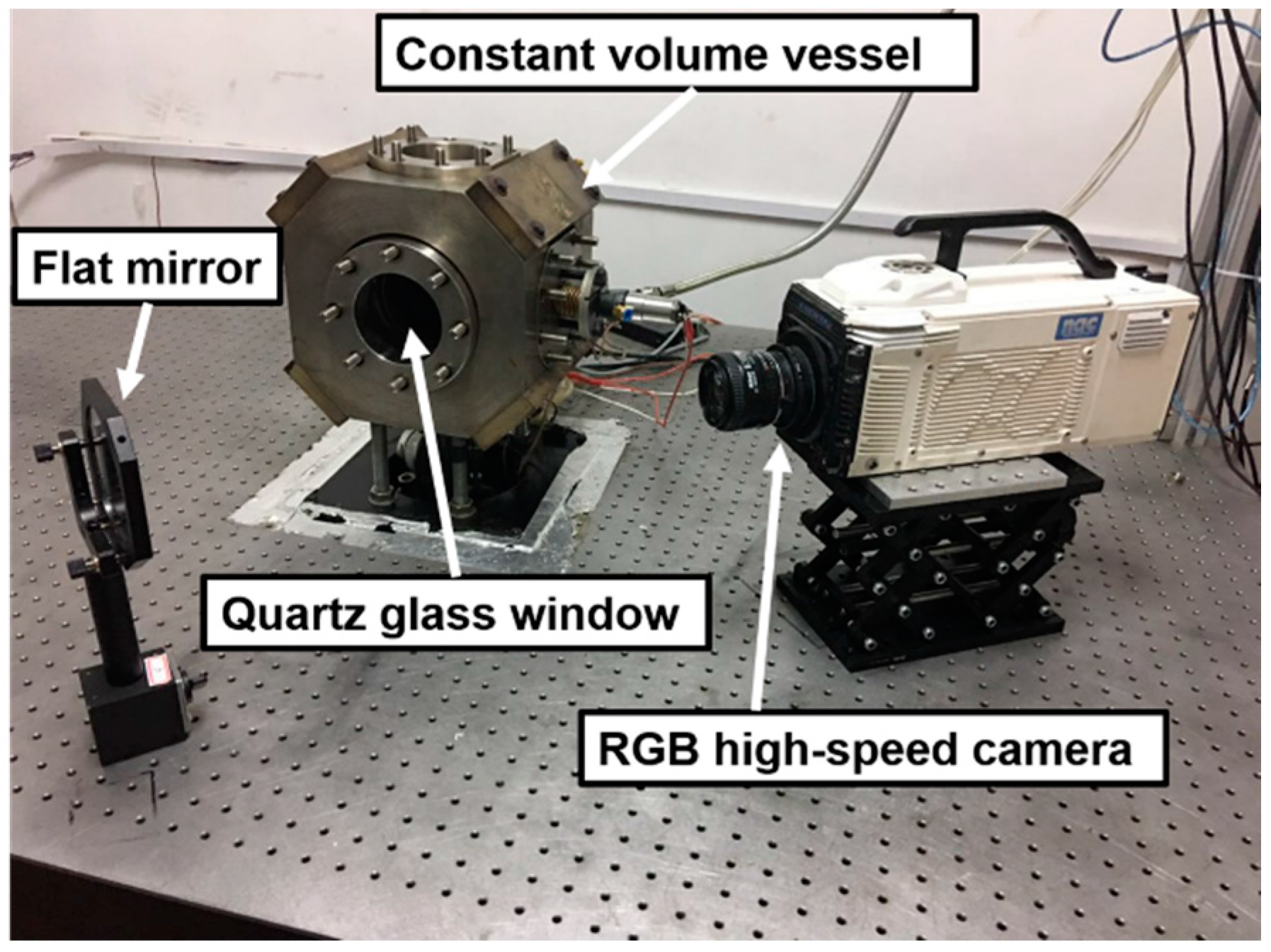
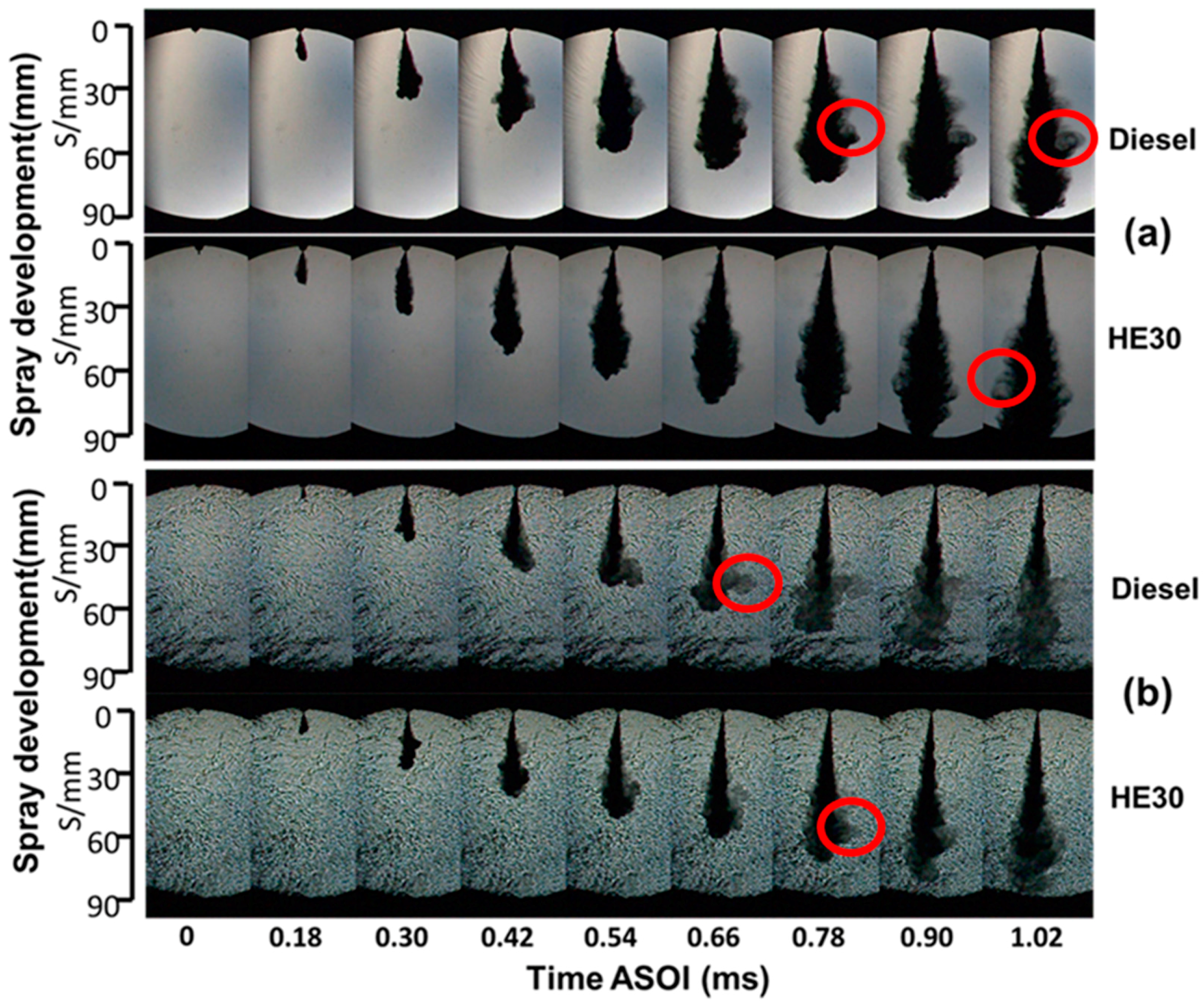
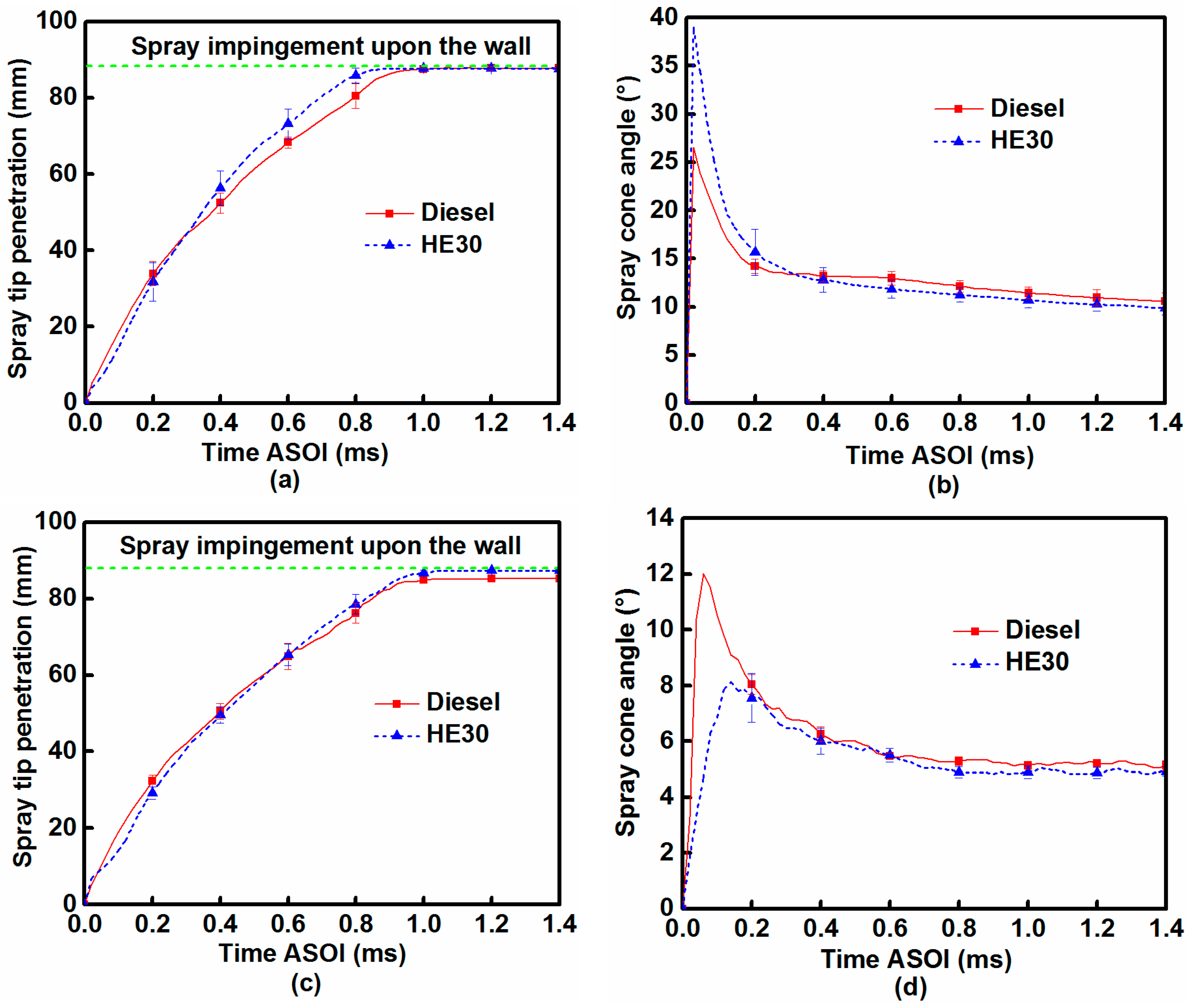
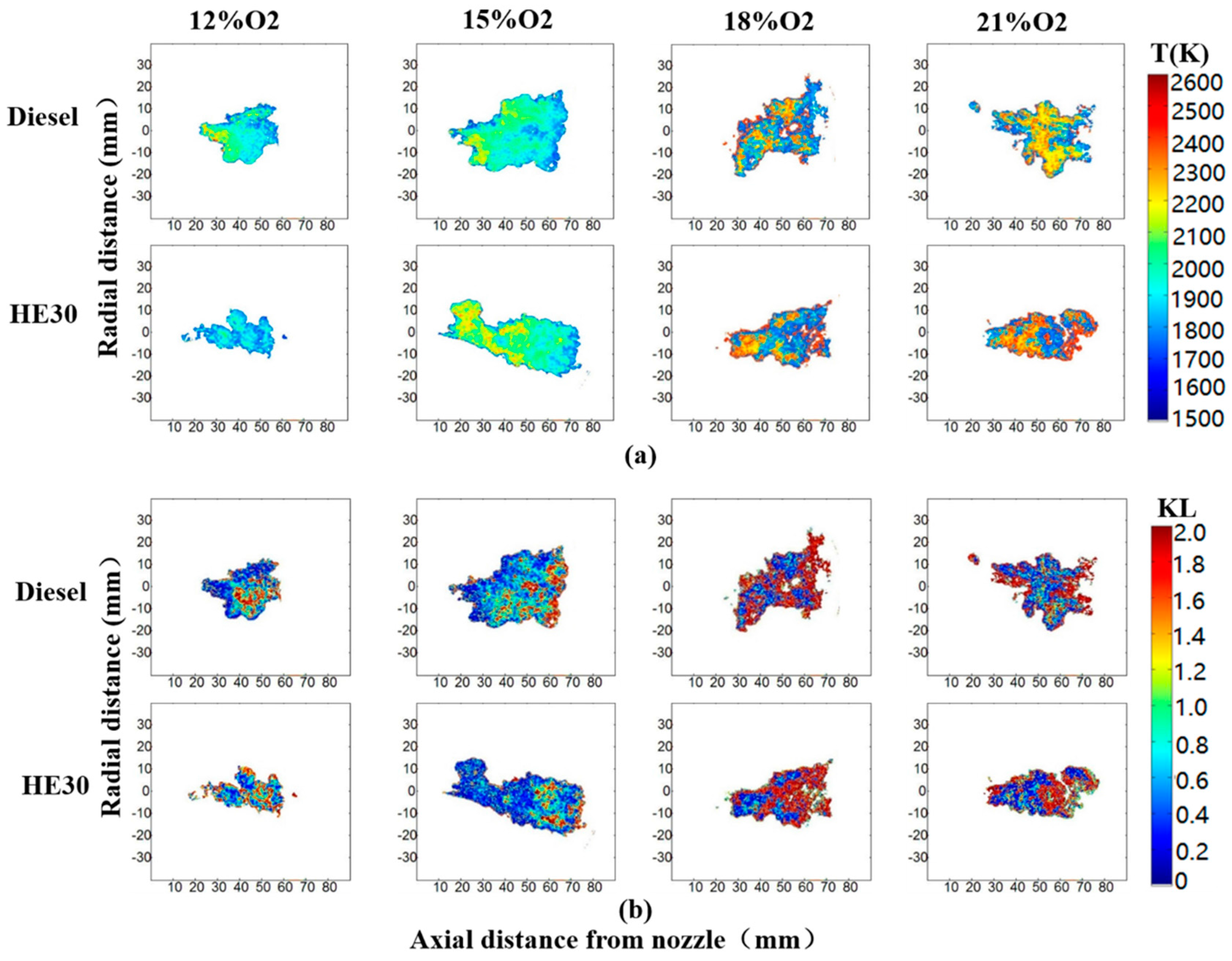
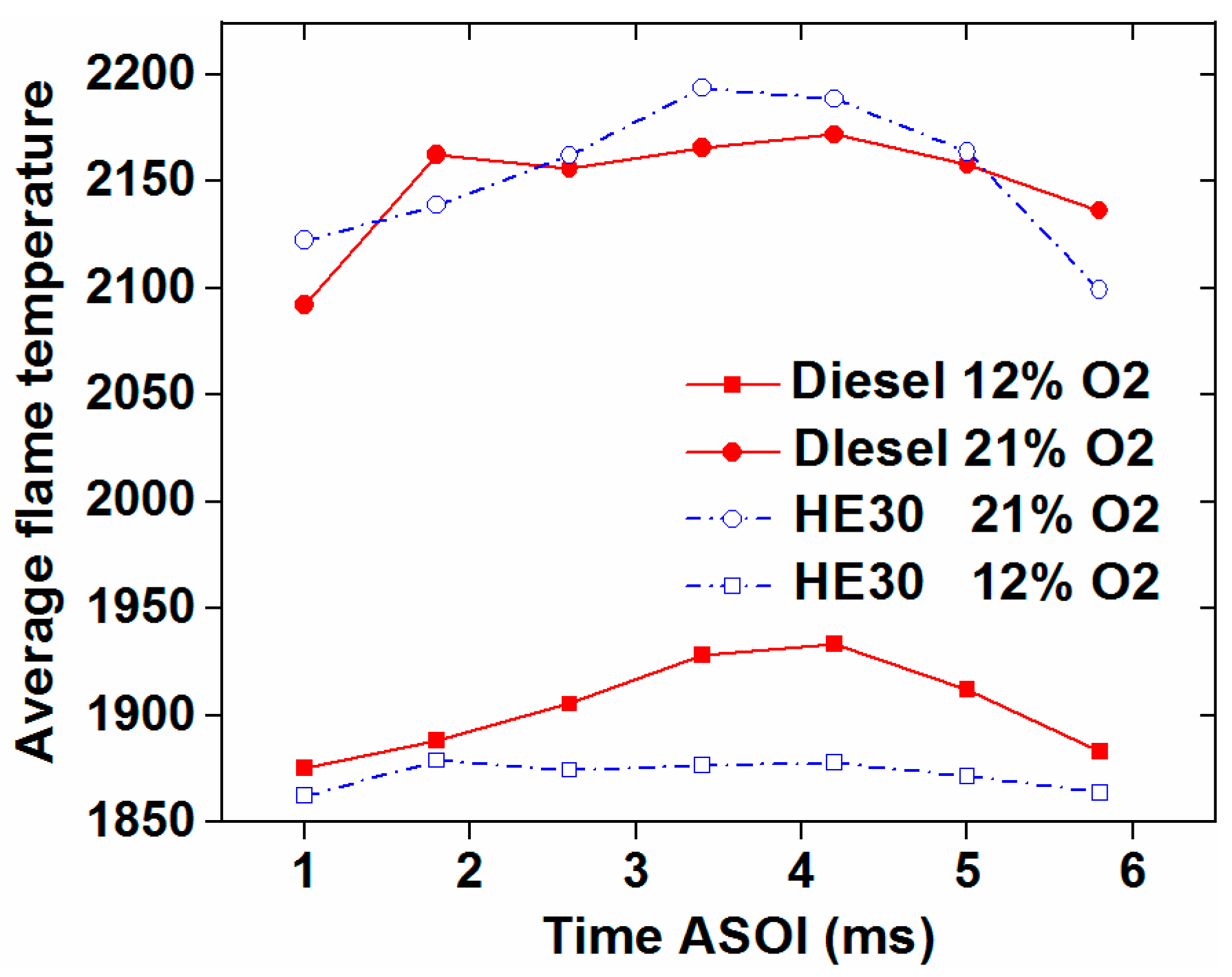

| No. | Instruments | Measuring Range | Accuracy | Percentage Uncertainties |
|---|---|---|---|---|
| 1 | BZY-201 | 0~400 mN/m | 0.01 mN/m | 0.04 |
| 2 | DLYS-101A | −2~+400 °C | ±0.5 °C | 0.125 |
| 3 | NDJ-8S | 10~200 104 (m2)/s | ±1.0% | 0.50 |
| Experimental Conditions | Spray | Combustion |
|---|---|---|
| Injector type | Mini sac | Mini sac |
| Orifice diameter (mm) | 0.28 | 0.28 |
| Ambient density (kg/m3) | 15 | 15 |
| Ambient temperature (K) | 900/293 1 | 900 |
| Injection pressure (MPa) | 120 | 120 |
| Injection duration (ms) | 2.2 | 2.2 |
| Imaging speed (fps) | 50,000 | 25,000 |
| Exposure time (μs) | 1.1 | 1.1/3 2 |
| F-number | 2.8 | 2.8/5.6 2 |
| Physicochemical Properties | Diesel | HE30 |
|---|---|---|
| Stable time (h) | - | 103 |
| Mass fraction of hydrous ethanol (%) | 0 | 28.3 |
| Density (kg/m3) | 818 | 831 |
| Surface tension (mN/m) | 28.5 | 28.4 |
| Kinematic viscosity @ 20 °C (mm2/s) | 3.35 | 4.02 |
| Latent heat of vaporization (kJ/kg) | 270 | 535 |
| Cetane number | 50 | 36 |
| Lower heating value (MJ/kg)) | 42.8 | 36.3 |
| Oxygen content (mass %) | 0 | 14.4 |
© 2017 by the authors. Licensee MDPI, Basel, Switzerland. This article is an open access article distributed under the terms and conditions of the Creative Commons Attribution (CC BY) license (http://creativecommons.org/licenses/by/4.0/).
Share and Cite
Zhang, X.; Li, T.; Ma, P.; Wang, B. Spray Combustion Characteristics and Soot Emission Reduction of Hydrous Ethanol Diesel Emulsion Fuel Using Color-Ratio Pyrometry. Energies 2017, 10, 2062. https://doi.org/10.3390/en10122062
Zhang X, Li T, Ma P, Wang B. Spray Combustion Characteristics and Soot Emission Reduction of Hydrous Ethanol Diesel Emulsion Fuel Using Color-Ratio Pyrometry. Energies. 2017; 10(12):2062. https://doi.org/10.3390/en10122062
Chicago/Turabian StyleZhang, Xiaoqing, Tie Li, Pengfei Ma, and Bin Wang. 2017. "Spray Combustion Characteristics and Soot Emission Reduction of Hydrous Ethanol Diesel Emulsion Fuel Using Color-Ratio Pyrometry" Energies 10, no. 12: 2062. https://doi.org/10.3390/en10122062
APA StyleZhang, X., Li, T., Ma, P., & Wang, B. (2017). Spray Combustion Characteristics and Soot Emission Reduction of Hydrous Ethanol Diesel Emulsion Fuel Using Color-Ratio Pyrometry. Energies, 10(12), 2062. https://doi.org/10.3390/en10122062




